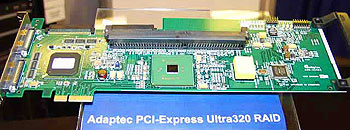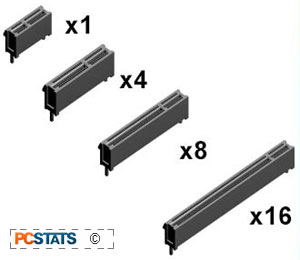Among other things, Intel
has suggested a topology for the future that would separate the computing unit from the monitor,
interface devices and external drives using PCI Express cable connections as a
go-between.
A concept PC like that would enable complete modularity in servers
and even desktop systems if manufacturers are willing to accept it. Of course, this
is significantly beyond the current plans for PCI Express, but if the technology is capable of supporting
more user friendly expressions of computer form, they will probably be
developed.
PCI was developed
in part to make computer configuration easier to handle, so there is no reason why PCI Express
should not take this to a new level. External video cards,
anyone? Speaking from past experiences, I don’t know
how many times external components have been mentioned as a ‘wave of the future’ type of
thing; how about an entirely component based PC like a stereo
system?
It is unlikely that the
makers of Firewire and USB 2.0 devices have much to worry about in the short
term, despite the apparent ability of the PCI Express technology to carry out their
roles without even requiring a bridge to connect to the rest of the I/O system.
USB and Firewire devices are already very common, and by the time external
devices supporting the PCI Express specification become available in a year or two, they
should have become so prevalent in the market that manufacturers will have to
continue support for them for the same reasons that PCI Express was designed to
coexist with PCI 2.2.
 Also, the ExpressCard format explicitly combines
USB 2.0 and PCI Express in a single slot for portable and small form factor
devices. This is both an indication that PCI Express is not necessarily
intended to supplant USB anytime soon, and a concession to the continued
usefulness of USB technology in the brave new world of sometime next
year.
Also, the ExpressCard format explicitly combines
USB 2.0 and PCI Express in a single slot for portable and small form factor
devices. This is both an indication that PCI Express is not necessarily
intended to supplant USB anytime soon, and a concession to the continued
usefulness of USB technology in the brave new world of sometime next
year.
PCI
Express does not compete with AMD's Hypertransport technology, but rather coexists with it in order to
move data more efficiently in chipsets like the nForce 4 and
K8T890.
Likewise,
PCI Express is intended to serve
as the underlying data-transport technology for I/O methods like serial ATA
and SCSI, not to replace them. PCI Express is going to replace AGP as
the conduit between the graphics chipset and the processor and memory
however.
 As you can see, the
modularity of the PCI Express system should enable it to carry out many different roles
in the computer industry. As manufacturers will have the capability of deciding
how much bandwidth to assign the needs of a specific market. Commenting on server
technology is slightly beyond the scope of this article, but it is easy to
see how PCI Express technology could work well in this high-data area.
As you can see, the
modularity of the PCI Express system should enable it to carry out many different roles
in the computer industry. As manufacturers will have the capability of deciding
how much bandwidth to assign the needs of a specific market. Commenting on server
technology is slightly beyond the scope of this article, but it is easy to
see how PCI Express technology could work well in this high-data area.
The PCI Express architecture is not
intended to replace current CPU/memory bus technology, but rather to
work with it by providing more available bandwidth and flexibility for the rest of the I/O
system.
While it was originally believed that the PCI Express developers
group might be looking at ways to standardize the CPU
and memory buses within the system as well this is not part of the final approved
specifications.
Industry heavyweights ATI, Nvidia, and even AMD have already
given PCI Express their support for years to come. With endorsements like that
it seems inevitable that the PCI Express I/O system will be the basis for the forseeable
future.
Find out about this and many other
reviews by joining the Weekly PCstats.com Newsletter today!
